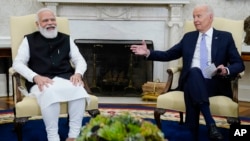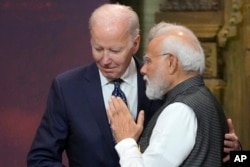In a clear sign that India is increasingly crucial for the United States, the White House will be rolling out its full pageantry on Thursday for Prime Minister Narendra Modi's official state visit and state dinner.
President Joe Biden has only twice previously extended such an invitation, the highest-ranking and most prestigious of White House visits, to French President Emmanuel Macron and South Korean President Yoon Suk Yeol, leaders of U.S. treaty allies.
Even the term "official state visit" is distinctive. As heads of government, prime ministers are usually invited on an "official visit" instead of a "state visit," which is given to heads of state such as monarchs, as well as presidents of countries where he or she is also the head of government.
The White House has not responded to queries about why Modi is given this exception. Protocol-wise, it will be a step up compared to his previous White House visits in 2014, 2016 and 2017, which were a "working visit," "working lunch," and "official working visit," respectively.
In a statement released before he left New Delhi, Modi said Biden’s invitation was a “a reflection of the vigor and vitality of the partnership between our democracies."
Key partner
For more than two decades, U.S. administrations have treated India as a key partner. Successive American presidents from Bill Clinton, George W. Bush, Barack Obama and Donald Trump have made the 15-hour flight to New Delhi.
Trump even campaigned for Modi, heaping praise on the Indian leader in front of tens of thousands of Indian Americans at a "Howdy, Modi!" 2019 rally in Texas. Modi reciprocated by hosting the "Namaste Trump" 2020 event where Trump was cheered on by a crowd of more than 100,000 in Ahmedabad, Modi's political homeland.
But no American president has granted Modi what Biden will this week — maximum display of White House respect and hospitality, including a full honor guard arrival and departure ceremony, lavish dinner reception and accommodation at Blair House, the official guest house located across the street from the White House.
It will be the same full-on pomp that Obama rolled out in 2009 for Indian Prime Minister Manmohan Singh.
Modi also will be invited to speak to a joint meeting of Congress on Thursday, his second time speaking to American lawmakers following his speech in 2016. His predecessors, Atal Bihari Vajpayee and Singh, delivered addresses in 2000 and 2005.
Geostrategic interests
Biden has at least two reasons to roll out the red carpet for Modi: to bolster India's role in the region to counterbalance China and to wean it off Russian arms.
India is the only country that has engaged in open conflict with China in the past decades. From Washington's perspective, a robust partnership with New Delhi is critical to realizing the U.S. vision of a free and open Indo-Pacific, said Ely Ratner, assistant secretary of defense for Indo-Pacific security affairs, at a recent event at the Center for a New American Security, a think tank working on defense and national security policies.
"A stronger India that can defend its own interest, and its sovereignty is good for the United States," he said.
Modi said India and the U.S. are collaborating to further “shared vision of a free, open and inclusive Indo-Pacific.” Local media have reported that during his visit, Modi will sign a $3 billion deal to purchase more than two dozen armed Predator drones for surveillance along India's border with China and Pakistan.
Another potential deliverable — a technology transfer by American company General Electric for state-owned Hindustan Aeronautics Limited to produce engines for Tejas military fighter jets at its facility in Bengaluru.
Critical and emerging technologies
In an effort to diversify supply chain away from China, the administration announced the Initiative on Critical and Emerging Technology (iCET) with India last year.
As part of iCET, earlier this month during National Security Adviser Jake Sullivan’s visit to New Delhi, India and the U.S. unveiled a road map for enhanced collaboration in high-technology areas, with a focus on addressing regulatory barriers and aligning export controls for smoother trade and “deeper cooperation” in critical areas.
"India is also seeking sensitive, critical and emerging technologies that the U.S. is often loath to share," said Donald Camp, chair in U.S.-India policy studies at the Center of Strategic and International Studies during a recent briefing at the nonprofit research organization. "So, they will be talking about cooperation in artificial intelligence and quantum computing."
Micron Technology Inc. is reportedly close to committing at least $1 billion toward setting up a semiconductor packaging plant in India — a deal blessed by the administration as it seeks to diversify the supply chain of chips away from China.
Russian weaponryTensions with China and Pakistan have long driven India to become the world's largest arms importer. From 2018 to 2022, it purchased 11% of the world's weapons, almost half of it from Russia, according to the international arms transfer report by the Stockholm International Peace Research Institute.
It's one of the reasons why India has been reluctant to condemn Moscow's invasion, said Aparna Pande, director of the Initiative on the Future of India and South Asia at the Hudson Institute.
The war on Ukraine, she told VOA, has provided the Biden administration a "once in a lifetime opportunity" to wean India away from its dependence on Moscow. "Because the equipment is not as easily available, spare parts are not coming through, and it's not really performing that well."
Russia was also the largest supplier of arms to India from 2013 to 2017, accounting for 64% of total Indian arms imports. It fell to 45% during the period from 2018 to 2022 due to increased domestic Indian arms production, and since 2022, constraints related to its invasion of Ukraine.
Global South
This year, India holds the presidency of the G20, a group of 20 developing and developed economies, including the G7, the world's seven richest democracies. It will host the G20 summit later this year, with an agenda heavy on the interests of the so-called Global South, shorthand for low- and middle-income countries.
Biden is expected to consult with Modi on the G7's outreach to the Global South, which is partly based on concerns about China's heavy footprint across the developing world, which is creating unsustainable levels of infrastructure debt in some countries, as well as Beijing's clout over supply chains and critical minerals.
A proposal is being pushed by Modi to give the African Union permanent membership at the G20. The move could be strategic to regain ground lost to China and Russia — countries that have taken a head start in forging relations with the group's 55-member nations, Beijing with its infrastructure loans and Moscow with its arms export.
Modi will also likely discuss with Biden the awkward task of finalizing the G20 guest list — whether to invite Russian President Vladimir Putin, whose country is a member. Amid threats of G7 leaders' boycott, last year's G20 president, Indonesia, navigated the diplomatic headache by convincing Putin to send his foreign minister and inviting Ukrainian President Volodymyr Zelenskyy to attend virtually as an observer.








